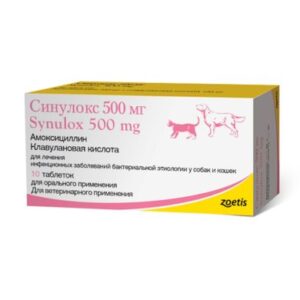

Clamovet powder for oral suspension for Cats, Dogs 50 ml
31.99 € Original price was: 31.99 €.25.79 €Current price is: 25.79 €.
| Animals | , |
|---|---|
| Brands | , |
| Form | , |
Clamovet, powder for oral suspension, 50 ml
Description
The powder is cream to light brown in color.
Composition
1 g of the drug contains active ingredients:
- amoxicillin (in the form of trihydrate) — 250 mg
- clavulanic acid (in the form of potassium clavulanate) – 62.5 mg.
Excipients: aspartame, xanthan gum, sodium benzoate, citric acid, sodium citrate, calcium stearate, silicon dioxide, crospovidone, sorbitol, flavoring, microcrystalline cellulose.
Pharmacological properties
ATC vet classification code QJ01 — Antibacterial veterinary drugs for systemic use. QJ01CR02 — Amoxicillin and β-lactamase inhibitor.
CLAMOXYVET is a combination drug of amoxicillin and clavulanic acid, a beta-lactamase inhibitor.
Amoxicillin is a semisynthetic aminopenicillin (β-lactam antibiotic). It disrupts bacterial cell wall synthesis by inhibiting the enzymes transpeptidase and carboxypeptidase, which causes osmotic imbalance and death of bacteria in the growth phase.
Clavulanic acid inactivates the ß-lactamase of the bacterial cell and, thereby, restores the sensitivity of the bacteria to the bactericidal action of amoxicillin at concentrations that are easily achieved in animal tissues after oral administration of the drug.
The drug is active against many gram-positive (Staphylococcus spp., Clostridium spp., Corynebacterium spp., Peptostreptococcus spp., Streptococcus spp.) and gram-negative (Escherichia coli, Salmonella spp., Klebsiella spp., Pasteurella spp.) bacteria, including ß-lactamase-producing strains of microorganisms.
The drug is not effective against infections caused by Pseudomonas spp.
Amoxicillin is well absorbed after oral administration. In dogs, bioavailability is 60–70%, in cats — 70–80%. Amoxicillin has a relatively small volume of distribution, low level of binding to plasma proteins (34% in dogs) and a short half-life. After absorption, its highest concentrations are found in the kidneys (urine) and bile, followed by the liver, lungs, heart and spleen. Distribution of amoxicillin in the cerebrospinal fluid is low, unless the meninges are inflamed.
After oral administration of amoxicillin to dogs, the maximum plasma concentration Cmax (7.31 μg/ml) is reached after approximately 1.37 hours. The mean elimination half-life of amoxicillin was 1.21 hours.
Amoxicillin is excreted from the body of dogs by active tubular excretion through the kidneys.
In cats, the mean Cmax of amoxicillin is 5.87 μg/ml and is reached after approximately 1.59 hours, and the mean half-life of amoxicillin is 1.18 hours.
Clavulanic acid is well absorbed after oral administration.
It penetrates poorly into the cerebrospinal fluid. Plasma protein binding is approximately 25%, and the half-life is short. Clavulanic acid is mainly excreted unchanged in the urine.
After oral administration of the drug to dogs, the mean Cmax of clavulanic acid (1.33 μg/ml) is reached after approximately 1.02 hours.
The average half-life of clavulanic acid is 0.83 hours.
In cats, the mean Cmax of clavulanic acid (3.16 μg/ml) is reached after approximately 0.70 hours. The mean half-life of clavulanic acid is 0.81 hours.
Clavulanic acid is excreted from the body mainly in the urine.
Application
Treatment of dogs and cats for diseases of the skin (including deep and superficial pyoderma), soft tissues (abscesses and anal sacculitis), oral cavity (in particular, gingivitis), urinary tract, respiratory tract (including diseases of the upper and lower respiratory tract), digestive tract (enteritis) caused by microorganisms sensitive to amoxicillin and clavulanic acid.
Dosage
Preparation of suspension.
Shake the vial with powder for oral suspension (8 g) to loosen the powder. Add water (boiled and cooled drinking water or distilled water) to the vial to 3–5 mm below the 40 ml mark on the label in the upper right corner, invert and shake thoroughly, then fill the vial with water to the mark, invert and shake thoroughly again.
Open the bottle and insert the syringe adapter included in the kit into the neck.
The suspension should be shaken thoroughly before each use.
The suspension is administered orally at a dose of 1 ml per 5 kg of body weight, which is equivalent to 12.5 mg of the combination of active ingredients of the drug per 1 kg of body weight (10 mg of amoxicillin and 2.5 mg of clavulanic acid per 1 kg of body weight), twice a day.
This dose is effective for most infections, including skin, urinary tract and gastrointestinal tract infections. In severe cases of respiratory tract infections, it is recommended to increase the dose to 25 mg of the combination of active ingredients per 1 kg of body weight (20 mg of amoxicillin and 5 mg of clavulanic acid per 1 kg of body weight) twice a day.
The course of treatment in normal cases, including all indications, usually lasts 5–7 days.
In severe or chronic cases, in which there is significant tissue damage, the recommended course of treatment is extended until the affected tissues are completely restored: chronic skin diseases – up to 10–12 days; chronic cystitis – up to 10–28 days; respiratory diseases – up to 8–10 days.
Contraindication
Hypersensitivity to penicillins.
The drug should not be used on horses, rabbits, guinea pigs, hamsters or other small herbivores.
Do not use in animals with serious renal impairment.
Do not use simultaneously with chloramphenicol, cephalosporin antibiotics, tetracyclines, macrolides.
Do not use in case of known resistance to the combination of amoxicillin/clavulanic acid.
Reservation
Side effect
Very rarely, animals may experience hypersensitivity reactions (allergic reactions) to penicillins after administration of the drug, as well as cases of digestive tract disorders (vomiting, diarrhea, anorexia). Treatment may be discontinued depending on the severity of side effects and the assessment of the benefit/risk ratio by the veterinarian.
Special precautions for use
In animals with impaired liver and kidney function, the drug should be used only after a risk assessment by a veterinarian.
Before using the drug, it is recommended to test the sensitivity of microorganisms that cause the disease to the active ingredients of the drug.
Use during pregnancy, lactation
It is recommended to use the drug in animals during pregnancy and lactation only when the benefits of the drug outweigh the possible risks, as decided by a veterinarian.
Interaction with other means and other forms of interaction
There is a possibility of allergic cross-reactivity with other penicillins. Penicillins may enhance the antibacterial activity of aminoglycosides.
Do not use simultaneously with chloramphenicol, cephalosporin antibiotics, tetracyclines, macrolides.
Overdose
The drug has low toxicity for target animal species. In case of accidental overdose, the expected side effects are unlikely.
Withdrawal period (withdrawal period)
Not regulated.
Special precautions for persons and service personnel
Personnel working with the product must follow the basic hygiene and safety rules adopted when working with veterinary drugs.
Penicillins and cephalosporins can cause hypersensitivity (allergy) after ingestion or skin contact. Hypersensitivity to penicillins can lead to cross-reactions with cephalosporins and vice versa.
Allergic reactions to these substances can be serious.
Personnel known to be hypersensitive to penicillins and/or cephalosporins are not allowed to handle the product. The product should be used with caution. If contact with the product occurs and symptoms of allergy (redness of the skin) occur, seek medical advice. Itching of the face, eyes or lips, difficulty breathing are more serious symptoms and require immediate medical attention. Very rarely, gastrointestinal disorders (vomiting, diarrhea, anorexia) may occur. Hands should be washed after handling the product.
Release form
Polymer vials containing 8 g of powder for the preparation of 40 ml of suspension are packed individually in cardboard boxes complete with a syringe adapter and a dosing syringe.
Storage
In a dry, dark place inaccessible to children at a temperature not exceeding 25 °C.
Expiration date
2 years. Shelf life of the prepared suspension is 7 days, if stored at a temperature of 2 to 8 °C.




























